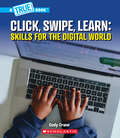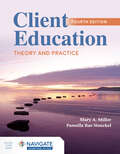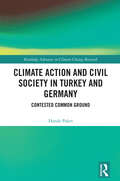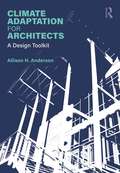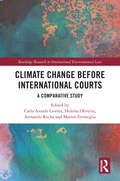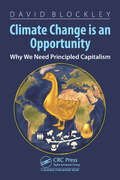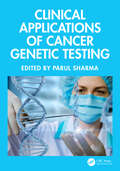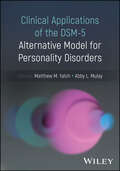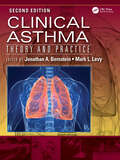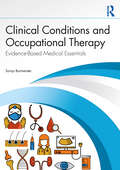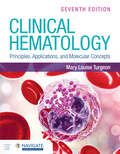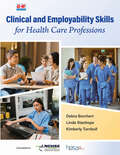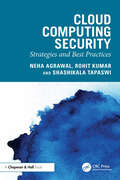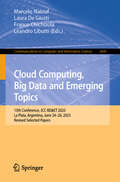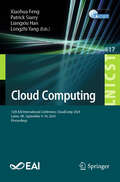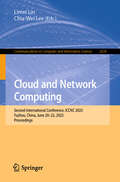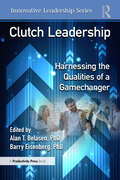- Table View
- List View
Click, Swipe, Learn: Skills for the Digital World (A True Book)
by Cody CraneHow can kids use the internet smartly? Discover it with this step-by-step guide for young readers.Kids spend about five hours a day connecting with digital content-consuming it and/or creating it. Some of that content might include misinformation and altered images. It may even promote biases or dangerous ideas. Creating content includes pitfalls too-from copyright infringement to posting information that could be harmful or damaging. That's why digital literacy is so important. Click, Swipe, Learn: Skills for the Digital World uses engaging, interactive text-including critical-thinking questions-to show kids exactly what they need to watch out for as they navigate the digital world.ABOUT THIS SERIES:The world of media and technology is changing fast-and young students are right there in the thick of it. As children try to make sense of new technologies, they face a variety of critical issues, including how to access reliable sources of information, how to protect themselves online, and how to use technology in mindful and respectful ways. That's where the books in the Our Digital Future series can help. Each title has been developed to help young readers think critically and navigate new technologies with confidence and care.
Client Education: Theory and Practice
by Mary A. Miller Pamella Rae StoeckelClient Education: Theory and Practice, Fourth Edition teaches nursing students the important skills of patient education and health promotion. The authors use their unique Miller-Stoeckel Client Education Model as the organizing framework to emphasize the importance of the Nurse-Client Relationship and how this relationship is paramount to the success of client education. They focus on the key role that nurses play in educating individuals, families and groups in clinical settings. The updated Fourth Edition addresses the need for health education in nursing by covering the learning process and discussing the needs of clients across the age span. The authors’ thoughtful revision includes updated statistics on chronic diseases and new data on generations Z and Alpha. Furthermore, they teach students how to work with culturally diverse populations by presenting specific teaching approaches.
Climate Action and Civil Society in Turkey and Germany: Contested Common Ground (Routledge Advances in Climate Change Research)
by Hande PakerThis book explores the social and political dynamics that shape the impacts of climate change, drawing upon Turkey and Germany to offer a comprehensive comparative analysis.Civil society representatives, the climate movement, the youth, and arts and culture actors from around the world unequivocally call for a deep transformation of political, economic, and social structures in order to avoid the devastating effects of climate change. The transformation that is prescribed is perceived as insufficient, technocratic, and market-based and does not involve challenging power relations at the heart of climate action. This book addresses these concerns, using a comparative analysis to explore the issues and efficiency of a meaningful sustainable transition. The in-depth comparison of two conventionally dissimilar cases, Turkey and Germany, demonstrates that civil society actors in different political settings can use similar strategies and frames for climate action against state actors. In turn, states use similar depoliticization strategies (albeit via different mechanisms) and economic growth narratives to reproduce hegemony. The book untangles the different processes that create the contentious, politicized common ground in which these stakeholders interact with each other. The findings of this research have significant implications for many developing and developed countries alike where climate policymaking is painstakingly inadequate.This book will be of interest to students, researchers, and academics interested in political ecology, climate politics, and politics of development.
Climate Adaptation for Architects: A Design Toolkit
by Allison AndersonArchitecture must adapt to protect people from the threat of climate change. About half of the world’s population lives in contexts that are highly vulnerable to climate change as hazards continue to intensify, with global disasters projected to reach 560 events per year by 2030, or 1.5 events every day. The accelerating frequency and intensity of disasters underscores the urgency to prepare for severe events to protect people, communities, and essential systems but also to protect the environment which provides shelter, livelihoods, cultural heritage, and public functions. This book provides a comprehensive reference of climate adaptation design tactics and a toolkit for adaptation to shocks and stresses, outlining the process for architects and designers to: Understand the risks posed by climate change to the built environment. Reduce the risks to people and the built environment from natural hazards. Reduce human vulnerability to shocks and stresses by strengthening resilience and adaptive capacity. Design the built environment to adapt to changes over its lifetime. Design buildings and cities to reduce dependence on fossil fuels. Preserve biodiversity and support natural resources. Climate Adaptation for Architects presents 45 adaptation tactics responding to the most consequential effects of climate change: heat, water, wind, and resource scarcity. Each chapter includes images, a definition, background information, key design considerations, potential impacts, and resources for further information. This is a valuable resource for every architect, landscape architect, urban planner, developer, and policymaker.
Climate Change Impacts on Workplace Health and Safety: Adaptations, Interventions and Responses
by Haruna Musa Moda Amir Hossein Khoshakhlagh Agnieszka Gruszecka-Kosowska Ravi RangarajanClimate change has become the primary serious human and environmental threat of the 21st century and, with associated variability, it presents enormous potential to affect workers' safety and health. This book delivers vital information regarding climate change adaptation measures and workplace health and safety interventions across diverse sectors.This edited book delivers relevant information for specialists and academics to compare good practices across different sectors to help improve workplace safety and health as climate change factors continue to impact indoor and outdoor workplaces. In addition, it highlights the impact of extreme heat exposure and risk of climate-related chronic diseases, which could impact productivity, occupational safety adherence and wellbeing of workers. It also covers the impact of reduced work capacity due to climate change variability on the jobs undertaken. Comprehensive, up-to-date and including the latest references and cutting-edge case studies, this book reveals to the reader how to adapt accordingly for the impacts of climate change and to understand what the key issues are likely to be.Climate Change Impacts on Workplace Health and Safety: Adaptations, Interventions and Responses is a sobering but essential read for academics, researchers and professionals in health, safety, and environment (HSE) roles, occupational health engineering and environmental health specialists. Its appeal will extend to climate change scientists, epidemiologists and business and management professionals.
Climate Change Mitigation and Adaptation to Improve Food Security in South Asia
by Mannava Sivakumar Rafiq Islam Heulin Thierry Ahm Mustafizur RahmanBoth food security and agriculture contribute to, and are affected by, global climate change. The Intergovernmental Panel on Climate Change reports that food production systems account for up to 37% of global greenhouse gas emissions. At the same time, these systems are increasingly vulnerable to climate change, with extreme weather events such as rising temperatures, flooding, drought, secondary salinity, and land degradation threatening food security in South Asia. Additionally, the spread of weeds, pests, and diseases due to shifting climates exacerbates these challenges. The strain on agriculture and food security from accelerated climate change is further worsening by rapid population growth. Globally, more than 820 million people suffer from hunger, and by 2050, food production will need to double to meet global demands. This intensification of farming, combined with climate change, will lead to greater reliance on reactive chemicals, water, and energy inputs—potentially damaging agroecosystem services and becoming increasingly difficult to manage. South Asia, with its high population growth, is particularly vulnerable to climate impacts such as flooding, salinity, droughts, and solar dimming. Rising sea levels and coastal erosion could result in the loss of 17% of land surface and 30% of food production by 2050.Agriculture and food systems must undergo innovative transformations to address these challenges. A comprehensive Climate Change Adaption Framework is essential for fostering a supportive policy environment, sharing information on climate impacts, and adapting climate-smart agriculture to enhance food security in South Asia. This book, based on the outcomes of the 2022 International Conference on Climate Change and Food security in South Asia, held in Dhaka, Bangladesh, explores key challenges and innovative solutions for mitigating and adapting to the impact of climate change on food security.
Climate Change and Sustainable Developments: Current Perspective and Technological Solutions (Earth, Environment, and Sustainability)
by Chitralekha Nag Dasgupta Ram Boojh Rachana SinghThis book focusses on climate change and sustainable scientific and technological solutions. It includes topics related to environmental pollution, extreme environments, greenhouse gases and global warming, effects of climate change on water resources and forest resources, depletion of fossil fuels and generation of renewable energy, human health, agriculture and food security as per the UNSDGs. It covers wastewater management, production of renewable energy carriers, and climate change policies developed by international bodies.The following are its features: Covers the current perspective and technological solutions to climate change with sustainable development model. Aims to address causes and impacts of the climate crisis with its long-term implication on the ecosystem. Addresses the key aspects related to current climate crisis and its sustainable interventions. Includes focused case studies based on technological solutions especially 'green solutions'. Describes all aspects of the climate crises including air, water and energy sectors. This book is aimed at graduate students and researchers in environmental engineering, renewable energy, climate change and sustainable development.
Climate Change before International Courts: A Comparative Study (Routledge Research in International Environmental Law)
by Carla Amado Gomes, Heloísa Oliveira, Armando Rocha and Matteo FermegliaThis book provides a comprehensive analysis of environmental law and climate change litigation within international courts, both substantively and procedurally. Climate change litigation is an area of continuous growth and complexity, particularly within international courts and bodies. This book uses a comparative approach, analysing case law from international sources. It focuses on three key areas, namely trends and features, legal grounds for litigation, and legal standing before courts. A concluding comparative chapter highlights the specific shortcomings and potential of each system in dealing with climate change problems, taking stock of fragmentation and unity in international law. The book presents instances in which international courts are applying procedural and substantive law to this disruptive, transnational, and intergenerational legal problem. It addresses gaps in the legal framework and identifies systems which are not fit for purpose.With international contributions from authors of diverse backgrounds, this book will be of interest to researchers in the field of climate change and environmental law, EU and international law, and international court litigation.
Climate Change is an Opportunity: Why We Need Principled Capitalism
by David BlockleyWe have an imperative, as never before, to change our ways. Climate change is presenting the entire human race with its greatest ever existential challenge. Like many I feel a growing sense of looming disaster. Yes, we are making some progress, but past agreements are not delivering. In this book I put a case for a new form of principled capitalism based on moral principles rather than utility and profit. I propose ten pillars that include systems thinking as citizens of the world and embracing Modern Monetary theory to guide decisions about macroeconomics and national debt.
Climate Change, Population Health and Island States: Socio-Cultural Dimensions
by Arnab Chakraborty Janaka Jayawickrama Yong-An ZhangThis unique collection examines climate change, disasters, and human health in both ‘developed’ and ‘developing’ island nations, highlighting the sociocultural issues in three countries: the UK, Sri Lanka, and Saint Vincent and the Grenadines.Examining how domestic and international policies often disregard the contributions which can be made by poor and marginalised communities, the book demonstrates how traditional ecological knowledge systems, which once enabled effective adaptation to environmental variability, have been systematically marginalised through processes of modernisation and globalisation. Furthermore, the book argues that the colonial model of prevention and responses should be reconsidered, advocating instead for a more inclusive, collaborative approach to climate-health governance – one that meaningfully incorporates local perspectives while addressing structural vulnerabilities to develop equitable, context-specific solutions for island states facing the escalating challenges of climate change and disaster-related health risks.This critical analysis will be of interest to students, scholars, and policymakers in public health, climate change and sustainability, disaster risk reduction, history, anthropology, sociology, and human geography.The Open Access version of this book, available at http://www.taylorfrancis.com, has been made available under a Creative Commons Attribution-Non Commercial-No Derivatives (CC BY-NC-ND) 4.0 license.
Climate Change: Impact of Elevated CO2 and Temperature on Crops, Weeds and Soil Microbes
by Rajeev Kumar Dasari Sreekanth P S BasavarajClimate Change: Impact of Elevated CO2 and Temperature on Crops, Weeds and Soil Microbes is a comprehensive and timely volume that explores the profound effects of climate change, specifically elevated CO2 and temperature on plant physiology, crop productivity, weed dynamics, and soil microbial interactions. The primary objective of this book is to provide a detailed and up-to-date overview of the physiological, biochemical, and molecular mechanisms governing crop responses to elevated CO2 and temperature. It also examines the impact on weeds and soil microbial communities, highlighting potential adaptation and mitigation strategies for sustainable agriculture. Readers will gain valuable insights into the latest methodologies and scientific advancements in this field.This volume offers in-depth coverage of key topics, including: Impact of elevated CO2 and temperature on the physiology, yield, and quality of major crops Responses of cereals, pulses, oilseeds, and vegetables to elevated CO2 and temperature Nutritional and quality changes in food crops under climate change scenarios Growth dynamics and physiological responses of weeds under elevated CO2 and temperature Role of soil microbes in plant health and ecosystem stability in changing climates Influence of elevated CO2 and temperature on key metabolic pathways, including photosynthesis, transpiration, redox metabolism, carbon metabolism, and nitrogen metabolism Adaptive mechanisms in crops, including osmo-protectant accumulation, phytohormonal regulation, and mitigation strategies for climate resilience As a significant contribution to climate change and plant science research, this book serves as an essential resource for plant physiologists, agronomists, environmental scientists, soil microbiologists, geneticists, and students. It is a valuable reference for researchers and professionals working on climate adaptation strategies in agriculture and can also be used in coursework for graduate and postgraduate studies.
Clinical Applications of Cancer Genetic Testing
by Parul SharmaThis text provides a clear and concise guide to the evolving role of genetic testing in oncology. Bridging research and clinical practice, it offers essential insights into genetic diagnostics, risk assessment, and personalized treatment. Designed for healthcare professionals, researchers, and students, this book simplifies complex concepts, making cutting-edge advancements in cancer genetics more accessible and applicable to patient care.Dr. Parul Sharma is dedicated to advancing the field of cancer genetics, driven by a commitment to bridging research and clinical practice. Through this text Dr. Sharma aims to make genetic insights more impactful in oncology. Her contributions to research have been recognized with the Young Researcher Award, the Research Luminary Award, and the Young Scientist Award, reflecting her passion for meaningful scientific progress. For her, every breakthrough in this field brings us closer to a future where cancer is no longer a life-defining diagnosis.Parul Sharma, PhD Assistant Professor, Chandigarh University, Punjab, India
Clinical Applications of the DSM-5 Alternative Model for Personality Disorders
by Matthew M. Yalch Abby L. MulayTransforming understanding and treatment of personality disorders with cutting-edge, evidence-based insights Clinical Applications of the DSM-5 Alternative Model for Personality Disorders is an important reference for clinicians and researchers using the Alternative Model for Personality Disorders (AMPD)—a dimensional diagnostic system for understanding personality pathology. The book covers the history, theoretical background, research evidence, and clinical application of the AMPD. With contributions from prominent clinician-researchers, this resource integrates emerging research findings with practical guidance on using the AMPD in various contexts. This book is divided into three sections. The first section offers an introduction to the AMPD that is useful for both newcomers to the model and researchers well versed in it. The second section reviews recent literature and offers case studies highlighting how the AMPD is applied in assessment and intervention. The third section covers cultural diversity, social justice, and the future of personality assessment. Together, this book's chapters offer a valuable outline of how the AMPD might be used in assessment and treatment planning. Compare the Alternative Model for Personality Disorders (AMPD) to traditional DSM-5 personality categories Access recent research findings and clinical application guidelines on a range of personality pathologies across multiple settings Link AMPD classifications to the International Classification of Diseases (ICD-11) Gain knowledge of the principles of context-specific personality assessment Personality researchers, mental health professionals, graduate students, and instructors will appreciate this thorough guide to the AMPD approach to treatment of mental health problems in general and personality pathology in particular.
Clinical Asthma: Theory and Practice
by Jonathan A. Bernstein Mark L. LevyEnormous progress in asthma research has been made in the past 50 years, including a greater understanding of its complex pathogenesis and new and more effective therapies. Consequently, the scientific literature has grown vast and can be difficult to integrate. With contributions from a distinguished panel of world-renowned authors, the Second Edition of Clinical Asthma: Theory and Practice presents a comprehensive study of both the common and the more challenging problems faced by all healthcare personnel who treat patients with asthma.The book is divided into seven sections, starting with the basics of asthma and ending with a discussion on the approach to asthma worldwide and in the primary care setting. Reflecting a strong clinical emphasis, each chapter begins with a patient case study supported by essential background information on the basic science and clinical decision-making process. This is followed by a discussion of clinical evaluation and management. The multidisciplinary coverage explores a range of topics including genetics, inflammation, immunology, and the identification of different endotypes. Using a bench-to-bedside approach, the book links basic science to the clinical management of asthma and explores options for improvement. The carefully selected authorship from experts worldwide presents a truly global outlook.
Clinical Conditions and Occupational Therapy: Evidence-Based Medical Essentials
by Sonja BurmeisterThis comprehensive and practical textbook provides an accessible, holistic, and concise guide for occupation therapy students and clinicians to bridge the gap between clinical occupational therapy practice and medical knowledge.Organized by body systems, this resource integrates foundational anatomy, physiology, condition-specific pathophysiology, standardized and non-standardized evaluations, and current evidence-based occupational therapy interventions. Designed to enhance clinical competency, it also provides an overview of patient signs and symptoms, medical diagnostic criteria, and evidence-based medical treatment approaches.With case studies throughout, Clinical Conditions and Occupational Therapy is an essential textbook for anyone studying occupational therapy or occupational science.
Clinical Fictions: Psychoanalytic Novelists and Short Story Writers
by Jeffrey BermanClinical Fictions: Psychoanalytic Novelists and Short Story Writers is the first book to explore works of fiction written by prominent psychoanalysts.Broken down into thematic sections, the book traces the literary output of pioneering psychoanalysts such as Julia Kristeva, Bruce Fink, Thomas Odgen, and Gregorio Kohon, among others. Berman looks at works of historical fiction, detective fiction, and the short story, and shows how recurring themes typical of these genres can be understood both psychoanalytically and through a literary lens. The works included investigate experiences of childhood adversity, life in dystopian societies, experiences of psychosis, bodily autonomy, personal loss and, above all, trauma. Unpacking these themes, and their depiction through fiction, Berman gives the reader the tools to apply psychoanalytic literary theory to further works. Interweaving his personal correspondence with authors, including a heartwarming exchange with Cliff Wilkerson, Berman offers unparalleled access to the inner workings of the writers’ minds.This book will be of interest to students and researchers using psychoanalytic literary theory, as well as mental health practitioners who are interested in the intersections between literature and psychoanalysis and discovering new ways of probing the unspoken and unconscious.
Clinical Hematology: Principles, Applications, and Molecular Concepts
by Mary Louise TurgeonClinical Hematology: Principles, Applications, and Molecular Concepts, Seventh Edition is designed to help students develop the professional entry-level competencies they need for certification and career success. The Seventh Edition strengthens the pedagogy that set the quality benchmark for hematology and includes the current, competency-based content needed by MLT and MLS students. Each new print copy includes Navigate Advantage Access that unlocks an interactive eBook, Appendices, Videos, Case Studies, and Flashcards.
Clinical Image-Based Procedures: 14th International Workshop, CLIP 2025, Held in Conjunction with MICCAI 2025, Daejeon, South Korea, September 23, 2025, Proceedings (Lecture Notes in Computer Science #16126)
by Stefan Wesarg Klaus Drechsler Marius Erdt Yufei Chen Moti Freiman Sarina Thomas Samah KhawaledThis book constitutes the proceedings of the 14th International Workshop on Clinical Image-Based Procedures, CLIP 2025, held in conjunction with the 28th International Conference on Medical Image Computing and Computer Assisted Intervention, MICCAI 2025, held in Daejeon, South Korea, on September 23, 2025. The 11 full papers included in this book were carefully reviewed and selected from 17 submissions. The workshop focuses on translational research and provides a forum for scientific work applied to clinical practice.
Clinical and Employability Skills for Health Care Professions
by Linda Stanhope Kimberly Turnbull Debra BorchertClinical and Employability Skills for Healthcare Professions is a comprehensive and versatile resource for students embarking on their clinical and internship experiences. This program can be used as a standalone course or supplementary material for other courses in the clinical program of study. The three units of this program prepare and guide students and instructors through clinical experiences to ensure students master the employability skills needed to succeed in the workplace.
Close Reading: The Basics (The Basics)
by David GreenhamClose reading is an essential skill that literature students continue to develop across the full length of their studies. This book, now in its second edition, is a complete guide to this foundational practice, providing an effective first principles methodology that can be used for poetry, novels, drama, and beyond.Offering model close readings of classic works of literature, including Hamlet, The Great Gatsby and Beloved, David Greenham presents a unique, contextual approach to close reading, while addressing key questions such as: What is close reading? What is the importance of the relationships between words? How can close reading enhance reading pleasure? Is there a method of close reading that works for all literary genres? How can close reading unlock complexity? How does the practice of close reading relate to contemporary theoretical, critical and political concerns? The second edition of Close Reading: The Basics is carefully formulated to bring together reading pleasure and analytic techniques that will engage the student of literature and enhance their reading experience.
Cloud Computing Security: Strategies and Best Practices
by Rohit Kumar Neha Agrawal Shashikala TapaswiThe book provides a fundamental exploration of cloud security, addressing the growing risks associated with modern cloud environments. It combines foundational theory with hands-on applications, equipping readers with the knowledge and tools needed to secure cloud platforms. Topics include cloud attack vectors, defence mechanisms, implementation challenges, and real-world case studies of major cloud service providers. Practical exercises and end-of-chapter questions reinforce key concepts, making this an essential resource. Designed for undergraduate and postgraduate students in computer science and cybersecurity, this book serves as a vital guide to securing cloud infrastructures and ensuring data integrity in a rapidly evolving technological landscape. Covers cloud security concepts, attack types, and defense mechanisms Includes cloud security tools, real-world case studies, and hands-on projects Discusses risk mitigation techniques and security best practices for cloud environments Examines real-world obstacles and solutions in cloud security adoption Analyses major cloud service providers and their security models
Cloud Computing, Big Data and Emerging Topics: 13th Conference, JCC-BD&ET 2025, La Plata, Argentina, June 24–26, 2025, Revised Selected Papers (Communications in Computer and Information Science #2649)
by Marcelo Naiouf Franco Chichizola Laura De Giusti Leandro LibuttiThis book constitutes the revised selected papers of the 13th International Conference on Cloud Computing, Big Data & Emerging Topics, JCC-BD&ET 2025, held in La Plata, Argentina, during June 24-26, 2025. The 12 full papers presented were carefully reviewed and selected from 35 submissions. They were focused on topical sections as follows: Parallel and Distributed Computing; Machine and Deep Learning; Smart Cities and E-Government; Visualization; Emerging Topics and Innovation in Computer Science Education.
Cloud Computing: 12th EAI International Conference, CloudComp 2024, Luton, UK, September 9–10, 2024, Proceedings (Lecture Notes of the Institute for Computer Sciences, Social Informatics and Telecommunications Engineering #617)
by Patrick Siarry Longzhi Yang Xiaohua Feng Liangxiu HanThis book LNICST 617 constitutes the refereed proceedings of the 12th EAI International Conference on Cloud Computing, CloudComp 2024, held in Luton, UK, during September 9–10, 2024. The 16 full papers were carefully reviewed and selected from 42 submissions. The proceedings focus on topics such as The Cloud-Edging Computing Wireless Networks; Network Security Emerging Applications /The Cloud-Edging Integration Applications
Cloud and Network Computing: Second International Conference, ICCNC 2025, Fuzhou, China, June 20–22, 2025, Proceedings (Communications in Computer and Information Science #2539)
by Chia-Wei Lee Limei LinThis book constitutes the proceedings of the Second International Conference on Cloud and Network Computing, ICCNC 2025, which was held in Fuzhou, China, during June 20–22, 2025. The 31 full papers presented in this volume were carefully reviewed and selected from 88 submissions. They are grouped into the following topics: Cloud & Edge Computing; Network Computing; Big Data Analysis and Artificial Intelligence; Security & Privacy.
Clutch Leadership: Harnessing the Qualities of a Gamechanger (Innovative Leadership Series)
by Alan T. Belasen and Barry EisenbergToday’s organizational leaders contend with a considerable array of potentially profound disruptive forces. Emerging information management and creation tools like AI and robotics, in conjunction with economic swings, global manufacturing shifts, and political instabilities, are creating immeasurable effects on business strategies and leadership practices. Transforming short-term challenges into long-term opportunities requires rising to the occasion, or what we call "clutch leadership." We believe that all leaders have it in them to be "clutch leaders!" Such is the thrust of this book.Clutch leaders have the skills to manage disruptions, break down silos, and align people around a compelling vision of success that represents a shift from "strategic fit" (matching resources and capabilities with opportunities) to "strategic stretch" (leveraging industry positioning to create competitive advantage). They create a productive and motivating sense of urgency and high aspiration in the organization during times of increased stakes. Clutch leaders build consensus in support of high-stakes decisions and model the way with a combination of confidence, capability, and conviction. Focusing on impact during disruptive times enables clutch leaders to harness the full potential of organizational resources beyond strategic fit, even if it requires a temporary push of skills and behaviors to extremes or taking on additional risks and opportunities (strategic stretch).What makes clutch leadership unique is the focus on "temporary imbalance" – the suspension of trade-offs between staying in the comfort zone versus playing to one’s tried and true strengths – until the gap is closed or until the new vision and reality are realigned through innovation and leverage. Clutch leaders’ distinctive ability to balance high-stress, big picture thinking with composure, agility, attention to detail, and strong logical reasoning with communication skills and empathy allows them to navigate fast-paced, challenging situations quickly and successfully.Numerous case studies are also included to illustrate innovative leadership techniques and applications.
